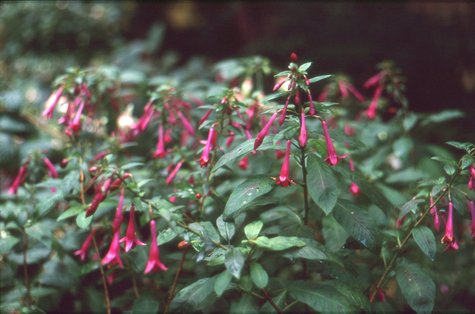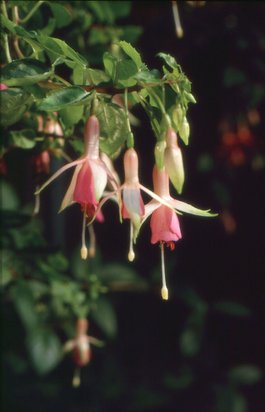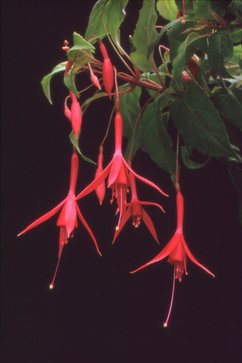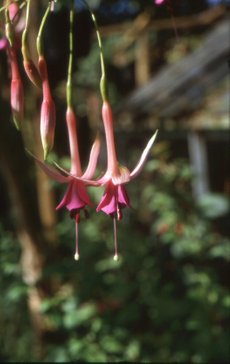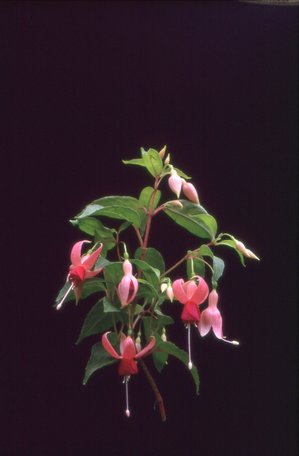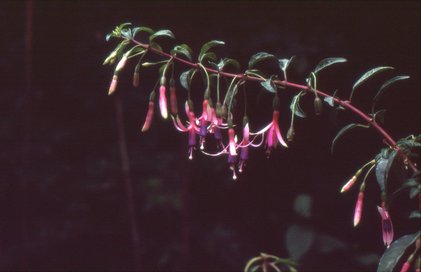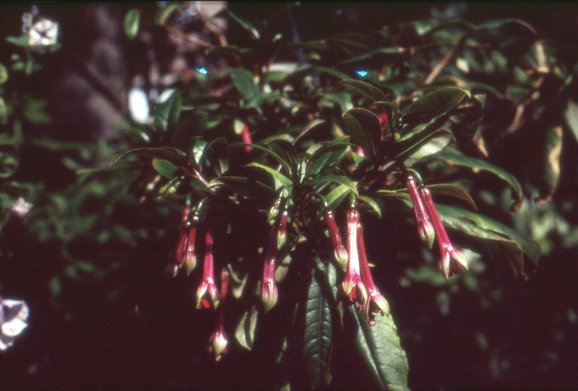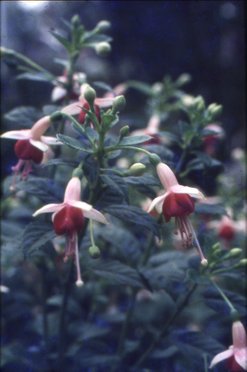The Rosea period
'Rosea'
It was in the mid-eighties that the achievements of the Dutch hybridizers ensured that closer contacts were established with their foreign colleagues. Herman played a pioneering role in this.
These contacts had the pleasant addition that more species in the Netherlands became available for the hybridizers. The fact that they eagerly used it speaks for itself.
In 1985, Herman introduced 'Maori Pipes' on the market, with F. excorticata as seed parent and F. triphylla as pollen parent.
These produced a triphylla hybrid that from the start through its separate color combination of tube and calyx, together with the light green leaf with brown-red aspects, claimed a place in the collection of collectors of triphylla cultivars.
But it was also during that time that suddenly there was another plant that was going to play a major role in the hybridizing work of Herman and later also of other hybridizers.
'Maori Pipes'
'Rosea' made its appearance.
'Rosea' was known from 1802 as F. spinosa and later as F. rosea and also as the false F. lycioides. Only in 1984 when the Botanical Group, through the Botanical Garden of Wageningen, came into possession of the real F. lycioides, it was suspected that the F. rosea or false F. lycioides in circulation was a possible natural hybrid of F. lycioides and
F. magellanica. For more certainty, crossings were made between F. lycioides and F. magelllanica.
Then the spelling of F. rosea was changed to 'Rosea'.
F. lycioides F. magellanica var. gracilis
'Rosea' is fast growing, is extremely fertile, has bunches of attractive flowers, and is easy to cultivate.
The hybridizers, united in the hybridizing group, with more botanical knowledge also saw the excellent properties of 'Rosea' but also realized that the pink color of F. lycioides should be present somewhere in the genes of the plant.
Similarly Herman. He set aside his aversion against the dominant colors of red and purple and went to work with 'Rosea'.
Of course, between the thousands of seedlings, which were grown as a mother from crosses with 'Rosea', there were many reddish-purple specimens and many plants that were look a likes and could therefore be removed directly from the battle scene. Nevertheless, there were percentages more seedlings than usual that deserved to populate the garden and greenhouse of villa Gerharda for a longer time to get a better picture of the quality of the plants and their new value.
In 1985 Herman brought the cultivar 'Aafje' into the limelight.
Aafje' originated from the crossing of 'Rosea' as a seed parent and a seedling of 'Dorothea Flower' x 'Golden Glow'. The desired rose of F. lycioides was immediately found in the elegantly shaped flower crown. From the same cross came a whole range of flower shapes and colors that confirmed the usability of 'Rosea' in the hybridizing work. Partly because of that, it was certainly not easier to select.
What was and what is not suitable to introduce?
'Aafje'
From the crossing (F. lycioides x F. magellanica) x ('Dorothea Flower' x 'Golden Glow') were selected by Herman in 1985 and offered for sale the cultivars: 'Bijou', 'Danseresje', '' Flirt ', 'Wentelwiek', 'Madurodam', 'Pink Rain', 'Petit Fleur', and 'Piet Hein'.
In 1986 'Kolibrie' followed 'Ultra Light' in 1987, 'Patricia Barnett' in 1989 and 'Vuurdans' in 1991.
Together with 'Aafje' 13 new cultivars from one cross. That is a lot, but if you look at the photos of these plants on this site, then that large number is perfectly justified.
'Kolibrie' 'Piet Hein'
Because of the wide variety of colors, flower shapes and combinations of these, they were not only new acquisitions for Herman, but also new cultivars in the already expanding range of Dutch cultivars. Curiously, a repetition of this crossing yielded nothing new. If you then have a cultivar with such good qualities as' Rosea 'and you have hybridizers' blood in your veins, then you are of course curious about what else is possible with it.
There were still enough cultivars that could be used as a cross parent with 'Rosea' but a real hybridizer also knows that a species is often the right basis for something new. And precisely those species were more available at that time than before.
'Pukkie'
Herman crossed 'Rosea' with his own cultivar 'Tsjiep' which in 1986 resulted in 'Pukkie' a cultivar where really everything is short and thus lives up to its name. In that same year also appeared 'Red Rain', 'Rosea' x F. triphylla, a triphylla cultivar with a rain of drop-shaped red flowers and very small leaves. This plant can even be used as a ground cover.
'Tempo Doeloe' from 'Rosea' x ('Bicentennial' x 'Golden Glow') also saw the light of day in that year and another cultivar in which a species was used as a pollenparent in 1986 was 'Lady's Smock', 'Rosea' x F. paniculata.
'Tempo Doeloe'
'Mood Indigo'
But by no means had all aspects of 'Rosea' been exploited.
'Rosea' as a seed parent and 'First Kiss' produced 'Eelco Brinkman' in 1987.
Also in 1987: 'Zulu Queen', 'Rosea' x F. excorticata, probably a cross made to bring the then emerging aubergine color into a cultivar, which was a step in the right direction.
The same was the case with 'Purple Rain' from the same cross
'Rosea' x F. excorticata.
'Sweety Dear' that year was the last 'Rosea' descendant with a species as a husband. F. magdalenae served as a seed parent, which was actually a daring crossing but worked perfectly well.
'Revival' and 'Mood Indigo' were the cultivars that the Rosea happen that year round both 'Rosea' crossed with a cultivar.
The last in the row of crossings with 'Rosea' was 'Zyzy' in 1992, with the ancient cultivar 'Venus Victrix' from 1840.
'Venus Victrix' x 'Rosea'
'Zy Zy'
During this 'Rosea' period something else also grew. Herman was in addition to the 'Rosea' adventures busy setting up a whole new line. Of course, the special cultivar that Herman did in 1986 should not go unnoticed.
The crossing F. excorticata with F. venusta brought 'Dark Venus' a beautiful plant with long dark red, somewhat exotic flowers, with thick leathery leaves. A plant that received too little attention in the Netherlands.
And despite and perhaps also because of the enormous supply of new cultivars by Herman, in 1987 there was a special cultivar. The cultivar 'Small Pipes' was approved. It was a special cross between the many presented plants and not only because the two species that were crossed came from two different sections.
'Dark Venus'
The species F. paniculata and F. triphylla, both not the easiest plants for hybridizingwork, yielded 'Small Pipes'. This merged two inflorescences, the umbelliferous truss of F. paniculata and the typical cluster formation of F. triphylla.
This unique combination barely penetrated the big fuchsia audience at the time. The breeders among them did realize that it was a unique combination. Nevertheless, this new cultivar was not used by them at the time. Agreements within the Hybridizing Group will have contributed to that at the time.
'Tsjiep'
But even in our time 'Small Pipes' is strangely enough used by only one hybridizer for a cross, which can be explained by the fact that the plant is not very fertile and working with small-flowered screen-flowerers is difficult.
For Herman himself it was a milestone he had achieved.
He also calls 'Small Pipes' as one of his most valuable acquisitions.
The way to normal fuchsia flowers in large screens or staggered bunches as he wished was open and that was a new period in his breeding career that we will describe later in chapter 8 about the pantri hybrids.
Reed more on: 5 de triphylla cultivars
Author: M.A. Soeters
Layout: S. van Schaik
© Fuchsia's of the World
